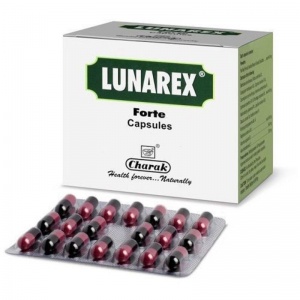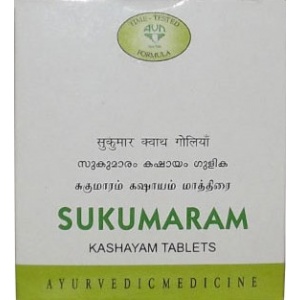Dysmenorrhea
Showing all 4 results
The term ‘Dysmenorrhea’ merely means painful periods. About 50-70 percent of women experience ‘menstrual cramps’ during their reproductive years.
What is Dysmenorrhea?
The term ‘Dysmenorrhea’ merely means painful periods. About 50-70 percent of women experience ‘menstrual cramps’ during their reproductive years. These cramps generally begin in the lower abdomen and they may rapidly spread to the back and thighs. For some women, it is just discomfort. But about 10% of women suffer from symptoms so severe that they are unable to go about their day to day activities. One survey showed that painful menstruation is the leading cause of lost time from school and work among women between the ages of 18-35.
What causes menstrual pains?
Studies indicate that there is some co-relation between the hormone prostaglandin, produced in the uterus with the cramps or pain. This hormone causes contractions in the uterus. The levels of this hormone were found to be quite high in females who reported severe menstrual pain than those who had very mild to mild discomfort. Medically, there are two types of dysmenorrhea: • Primary dysmenorrhea - This type of pain is not related to any clinical pathology, i.e. any problems of uterus or pelvic organs.• Secondary dysmenorrhea - The menstrual pain is because of some underlying pathology or structural abnormality, eg. endometriosis, fibroids, or infection of the uterus.Primary Dysmenorrhea usually occurs during puberty. It occurs due to secretion of Prostaglandins hormone, that helps the uterus to contract and shed the lining of the uterus during menstruation. This contraction causes mild cramps, and is considered normal. It often gets better after the age of 25 and after vaginal childbirth.Secondary Dysmenorrhea is commonly seen after the age of 30 years. It is associated either with a uterine condition, such as endometriosis, sexually transmitted diseases (STDs), pelvic inflammatory disease, ovarian cysts, hormonal imbalances, etc. Sometimes IUD or intrauterine device may also cause severe cramps.
What are the symptoms of dysmenorrhea?
Whether it is primary or secondary dysmenorrhea, pain is the common symptom. Some women experience very severe cramps and pain while others just complain of mild discomfort. The intensity and nature of pain varies from person to person. The pain itself can vary and women will generally experience two types of pain:• A constant low dull backache which may spread to the thighs.• Cramping spasmodic pains like contractions Along with pain, the other accompanying symptoms may include :• Nausea • Vomiting • Diarrhea/constipation • Fainting • Light-headedness • Feeling dizzy • Headaches • Exhaustion and lethargy • Breast tenderness.
How is dysmenorrhea diagnosed?
If a patient reports of severe menstrual pain, the gynecologist or physician first takes a complete case history focusing on menarche (onset of menses), the menstrual history and obstetrical history. He may then perform a physical examination, including an internal examination to see if there are possible abnormalities causing the pain. The tests which may be advised are:• Pap smear• Blood tests and cultures • UltrasoundIf the menstrual pain is not relieved with a mild painkiller or if a secondary cause of dysmenorrhoea is suspected, a surgical procedure called a laparoscopy may need to be performed.
What are the treatment options for dysmenorrhea?
The first step of action in any therapy is diagnosing whether dysmenorrhoea is because of primary or secondary cause. If there is an underlying pathology, such as a sexually transmitted disease, or then the aim of the treatment becomes to correct that abnormality first.
Conventional method Nonsteroidal anti-inflammatory drugs (NSAIDs), are most commonly prescribed by allopathic practitioners. eg. ibuprofen and naproxen. Although they are very effective in treating primary dysmenorrhea but they cause gastro-intestinal problems in sensitive subjects. Oral contraceptives are generally the second line of therapy. But Of course this method does not apply to women who wish to conceive.Is there a natural, safe method to treat dysmenorhea?
VedHerbs therapy
VedHerbs therapies are the evolutionary result of years of homeopathic, Chinese, ayurvedic, synergetic and bioenergetic research. Our therapeutic methods are based on the understanding that a disease is a state of disharmony produced at the physical, energetic, mental and emotional levels. Natural therapies work by appealing to the intelligence and sense of balance inherent in all nature. We remind and coax the body into producing hormones and secretions optimally rather than providing them to the body directly from the outside. In case of primary dysmenorrhoea, pains occur because of uterine vasoconstriction, anoxia and pelvic contractions. Besides this, any sort of deficiency in the body promotes poor nutrient uptake and thereby affects immunity. If your body’s immunity is low, one becomes vulnerable and susceptible to various infections. So Our treatment kits ensure that they not only extend their anti-inflammatory and pain relieving effects but also supply the body with proper nutrients. They are formulated in such a way that they also stabilize the endocrine axis. They produce effects both at cellular and biological level.
Tips for reducing symptoms of dysmenorrhea
• Applying fermented heat against the lower abdomen, can provide some relief from menstrual pain.
• Drink warm beverages.
• Eat small and frequent meals to avoid constipation or bloating symptoms.
• Follow a diet rich in complex carbohydrates such as whole grains, fruits, and vegetables, but low in salt, sugar, alcohol, and caffeine.
• Practice relaxation techniques like meditation or yoga. These can help shift focus from the pain.





